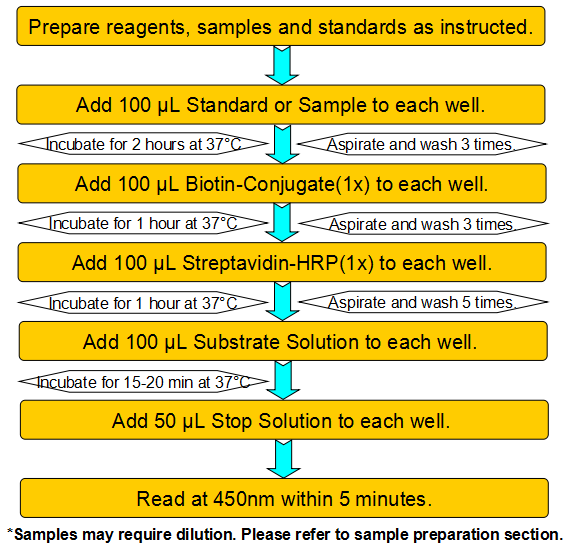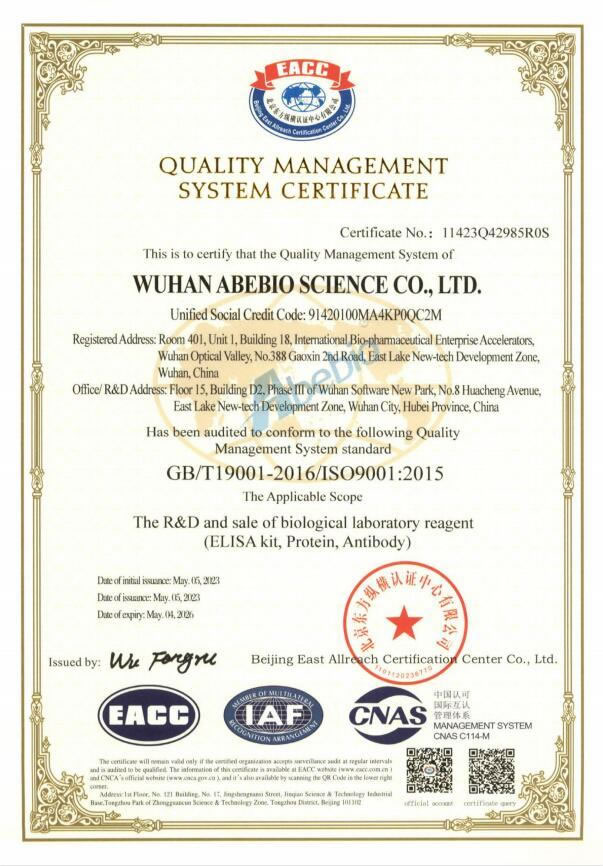Product Details
| Species Reactivity |
Mouse (Mus musculus) |
| UniProt |
N/A |
| Abbreviation |
dsDNA |
| Alternative Names |
N/A |
| Range |
0.31-20 ng/mL |
| Sensitivity |
0.156 ng/mL |
| Sample Type |
Serum, Plasma, Other biological fluids |
| Detection Method |
Competitive |
| Analysis Method |
Qualitative |
| Assay Duration |
1-3h |
| Sample Volume |
1-200 μL |
| Detection Wavelengt |
450 nm |
Test principle
This assay employs the competitive enzyme immunoassay technique. The microtiter plate provided in this kit has been pre-coated with an antibody specific to dsDNA. Standards or samples are then added to the appropriate microtiter plate wells with a Horseradish Peroxidase (HRP)-conjugated dsDNA and incubated. The competitive inhibition reaction is launched between with HRP labeled dsDNA and unlabeled dsDNA with the antibody. A substrate solution is added to the wells and the color develops in opposite to the amount of dsDNA in the sample. The color development is stopped and the intensity of the color is measured.
Product Overview
Antibodies against dsDNA are found during active phases of SLE. The amount of the serum concentration is positively correlated with the severity of the disease. Thus, detection of these autoantibodies is important for the diagnosis and the clinical monitoring of SLE. Consequently it has been established as 1 of the 11 ACR-criteria for the diagnosis of SLE. Most patients with SLE display IgG class antibodies against dsDNA. These autoantibodies are associated with lupus nephritis.Approximately 30% of the SLE patients develop IgA class anti-dsDNA antibodies, additionally. There have been suggestions that the presence of these IgA class anti-dsDNA antibodies may define a certain subset of SLE patients. Indeed studies demonstrated the association of this subclass with certain parameters of the disease activity.
Components
Reagents |
Quantity |
Reagents |
Quantity |
Assay plate (96 Wells) |
1 |
Instruction manual |
1 |
Standard (lyophilized) |
2 |
Sample Diluent |
1 x 20 mL |
Biotin-Conjugate (concentrate 100 x) |
1 x 120 μL |
Biotin-Conjugate Diluent |
1 x 12 mL |
Streptavidin-HRP (concentrate 100 x) |
1 x 120 μL |
Streptavidin-HRP Diluent |
1 x 12 mL |
Wash Buffer (concentrate 25 x) |
1 x 20 mL |
Substrate Solution |
1 x 10 mL |
Stop Solution |
1 x 6 mL |
Adhesive Films |
4 |
Specificity
This assay has high sensitivity and excellent specificity for detection of Mouse dsDNA. No significant cross-reactivity or interference between Mouse dsDNA and analogues was observed.
Recovery
Matrices listed below were spiked with certain level of recombinant Mouse dsDNA and the recovery rates were calculated by comparing the measured value to the expected amount of Mouse dsDNA in samples.
Precision
Intra-assay Precision (Precision within an assay)
Three samples of known concentration were tested twenty times on one plate to assess intra-assay precision.
Inter-assay Precision (Precision between assays)
Three samples of known concentration were tested in forty separate assays to assess inter-assay precision.
CV (%) = SD/meanX100
Intra-Assay: CV<8%
Inter-Assay: CV<12%
Linearity
The linearity of the kit was assayed by testing samples spiked with appropriate concentration of Mouse dsDNA and their serial dilutions. The results were demonstrated by the percentage of calculated concentration to the expected.
Stability
The stability of ELISA kit is determined by the loss rate of activity. The loss rate of this kit is less than 5% within the expiration date under appropriate storage condition.
The loss rate was determined by accelerated thermal degradation test. Keep the kit at 37°C for 4 and 7 days, and compare O.D.values of the kit kept at 37°C with that of at recommended temperature. (referring from China Biological Products Standard, which was calculated by the Arrhenius equation. For ELISA kit, 4 days storage at 37°C can be considered as 6 months at 2 - 8°C, which means 7 days at 37°C equaling 12 months at 2 - 8°C).
Sample collection and storage
Serum: Use a serum separator tube (SST) and allow samples to clot for two hours at room temperature or overnight at 2 - 8°C before centrifugation for 15 minutes at 1000 × g. Remove serum and assay immediately or aliquot and store samples at ≤ -20°C. Avoid repeated freeze-thaw cycles.
Plasma: Collect plasma using EDTA, or heparin as an anticoagulant. Centrifuge for 15 minutes at 1000 × g at 2 - 8°C within 30 minutes of collection. Assay immediately or aliquot and store samples at ≤ -20°C. Avoid repeated freeze-thaw cycles.
Other biological fluids: Centrifuge samples for 20 minutes at 1000 × g. Remove particulates and assay immediately or store samples in aliquot at -20°C or -80°C. Avoid repeated freeze/thaw cycles.
Kits storage instructions
Store at 2-8°C. Please refer to Instruction Manual.



